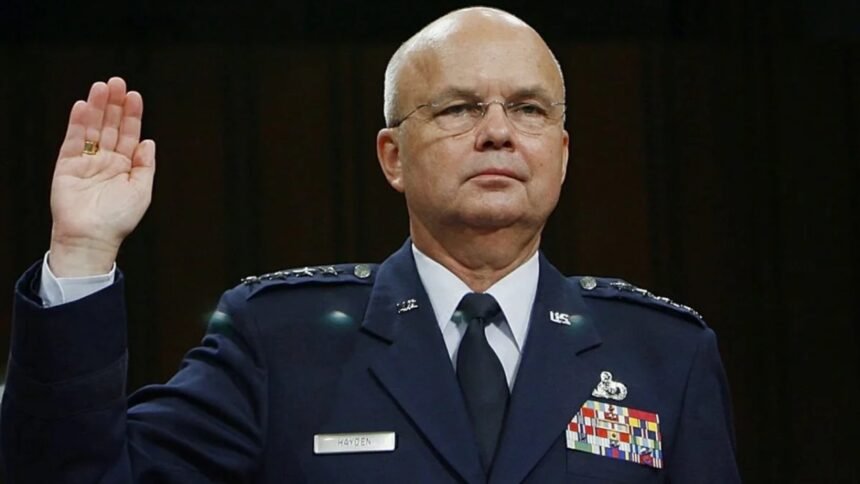In the fast-changing arena of American intelligence and national defense, few names carry as much weight as General Michael Hayden. A former four-star Air Force general, Hayden directed two of the most powerful intelligence agencies in the United States: the Central Intelligence Agency (CIA) and the National Security Agency (NSA). He led these institutions through some of the most turbulent periods in American history. His leadership offers not only a historical lens but also a prescription for understanding contemporary intelligence challenges. In this article, we will uncover six powerful insights that define his distinguished career and enduring legacy.
Architect of National Intelligence – General Michael Hayden
General Michael Hayden was born in 1945 in Pittsburgh, Pennsylvania, and began his military career with the U.S. Air Force in 1967. Rising through the ranks, he did not ascend to the top of the intelligence community overnight—it was the result of decades of experience, discipline, and an in-depth understanding of global threats.
He is perhaps best known for serving as the Director of the NSA from 1999 to 2005 and the CIA from 2006 to 2009. These appointments coincided with monumental global events such as the September 11 attacks and the global war on terror. Under his guidance, U.S. intelligence agencies launched surveillance programs, counterterrorism initiatives, and cyber intelligence frameworks that laid the foundation of 21st-century security doctrine.
At the NSA, Hayden oversaw the shift from Cold War-era signals intelligence to a modern, digital-first approach. Later, under President George W. Bush, he directed the CIA through controversial programs, including data surveillance and enhanced interrogation methods, earning both criticism and praise from civil liberties groups and policy experts.
Insight 1 – Consolidating the Divide Between NSA and CIA
One of Hayden’s most impactful achievements was his ability to lead both the NSA and CIA—two of the most complex and politically charged agencies in U.S. government. While each agency has its own unique mandate, Hayden’s rare crossover enabled him to streamline operations, improve communication, and facilitate inter-agency intelligence sharing.
Under his leadership, cooperation between the NSA and CIA—particularly in identifying and targeting high-value terrorist operatives—improved dramatically. This enhanced coordination played a significant role in strengthening homeland security efforts after the 9/11 attacks.
“Michael Hayden’s tenure across both intelligence giants allowed for a rare continuity of vision, something extremely valuable in wartime intelligence operations,” says Dr. Amy Zegart, senior fellow at Stanford’s Hoover Institution.
(Zegart, 2007, Journal of Intelligence and National Security)
Insight 2 – Advocacy on the Digital Intelligence Age
Hayden foresaw that the future battlefield would exist not only in physical spaces but also in cyberspace. During his time at the NSA, he led significant modernization efforts, transitioning from analog systems to advanced digital networks capable of real-time global surveillance.
One of his most controversial initiatives was the Stellar Wind program, launched post-9/11. It aimed to collect and analyze metadata from domestic communications to detect terrorist activity. Although criticized as government overreach, the program represented a turning point in intelligence methods and established cyberspace as a key front in national defense.
Insight 3 – Ethical Quicksands in Counterterrorism
Despite Hayden’s undeniable contributions to U.S. intelligence infrastructure, some of his decisions were fraught with ethical dilemmas. At the CIA, he authorized the use of enhanced interrogation techniques, including waterboarding and sleep deprivation.
Though legal under specific Department of Justice memos at the time, these tactics sparked a nationwide debate about morality, legality, and their overall effectiveness. Hayden defended them as actions taken under lawful authority with the sole purpose of protecting lives in high-risk scenarios.
According to a 2012 study in the Harvard National Security Journal, the results of these techniques were mixed and raised broader questions about whether the U.S. could maintain moral authority in the war on terror.
Insight 4 – A Promotion of Transparency Post-Tenure
After retiring, General Michael Hayden became a leading voice in public discussions on national security and civil liberties. His 2016 memoir, Playing to the Edge: American Intelligence in the Age of Terror, offered unprecedented insight into the post-9/11 intelligence community.
In public speeches and media interviews, Hayden often emphasized the importance of balancing national security with constitutional freedoms. He cautioned against overreach while underscoring the necessity of vigilance in a digital, globalized world. His nuanced perspective reflects the struggle to reconcile freedom with safety in modern society.
Insight 5 – Handling Health and Cognitive Decline
In 2018, Hayden suffered a serious stroke that affected both his speech and mobility. Despite these challenges, he has remained active in promoting intelligence reform and democratic values. He continues to contribute through op-eds, think tank discussions, and advisory roles.
His resilience has earned bipartisan admiration and serves as a powerful reminder of the importance of cognitive transparency among leaders tasked with safeguarding national security.
Insight 6 – Training the Next Generation of Analysts
Hayden’s commitment to national service did not end with his government career. As a visiting professor at George Mason University and founder of the Michael V. Hayden Center for Intelligence, Policy, and International Security, he mentors aspiring intelligence professionals and contributes to scholarly research.
Through lectures, simulations, and academic publications, he ensures that future analysts are well-equipped to handle complex global crises. These initiatives preserve his legacy not only in policy but in the people who carry it forward.
General Michael Hayden and the Surveillance-Freedom Dilemma
Perhaps the most defining debate surrounding General Michael Hayden is his stance on balancing surveillance and civil liberties. He maintains that intelligence services must walk a tightrope—protecting national security without compromising fundamental freedoms.
This discussion ties into modern-day concerns involving data privacy, mass surveillance, and AI-based intelligence systems. A 2019 study by Woods in the Journal of Digital Ethics found that public trust in surveillance programs grows when oversight mechanisms are clearly outlined—something Hayden has consistently advocated in his post-retirement work.
Tribute – An Unpopular but Necessary Patriot
General Michael Hayden is a paradoxical figure—revered by some as a tireless protector of American safety, and criticized by others as emblematic of intelligence overreach. Nevertheless, his impact on post-9/11 intelligence architecture is indisputable.
From directing the NSA and CIA during pivotal times to anticipating digital threats and mentoring the next generation, Hayden exemplifies the modern complexities of intelligence leadership. His legacy reminds us that the lines between heroism and controversy are often blurred in matters of national security.
In today’s digital age, where technology and threats evolve rapidly, Hayden’s career offers enduring lessons: vigilance must never come at the cost of liberty, and security must always be anchored in accountability.
you may also like
Elon Musk Petition Sign Up: 7 Reasons Why You Should Act Now






